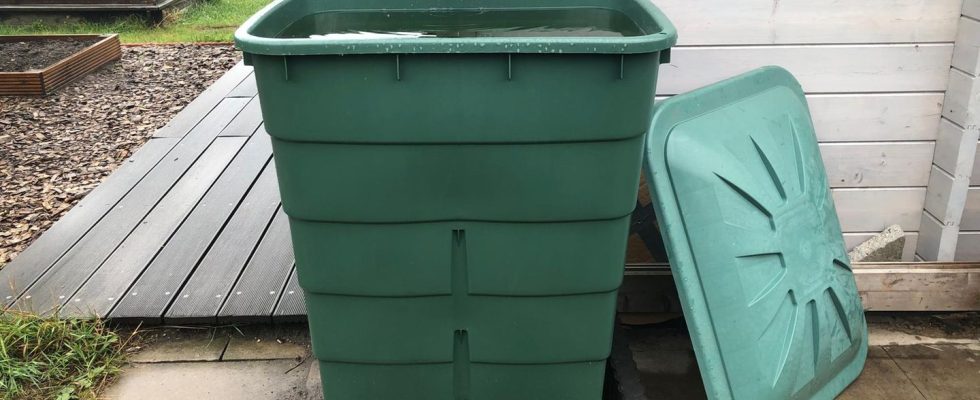Gardening tips
Collect rainwater: barrel, tank, cistern – this is how you cleverly collect the precious drops
Puristic and inexpensive: Classic rain barrels have many advantages. However, when there is heavy rainfall, they quickly reach their limits.
© Jan Sägert
Drinking water is precious. Rainwater too. Therefore, gardeners and homeowners should use it responsibly. Collecting rainwater: We explain how you can cleverly collect the precious water from above.
It’s like magic. For two weeks not a single droplet falls from the sky. There is a yawning emptiness in the rain barrel. To ensure that the laboriously grown tomatoes, cucumbers and zucchini, as well as the lawn, don’t die of thirst, you need a garden hose and therefore clear, but usually very calcareous, rather hard water. But suddenly – out of nowhere, the heavens open the floodgates. Within hours, hundreds of liters of the finest rainwater rush through the downpipe into the barrel. She has to give up at some point. And the sorely missed water from above seeps away, never to be seen again. This can be done better.
We explain how you can collect rainwater cleverly. Why round barrels are better than square ones – and how to prevent the rain collectors from overflowing.
Collect rainwater: There are two options
Rainwater is precious. Also because it rains less and less in some regions of Germany. But much more, because it contains neither chlorine nor other chemical additives that many plants in the garden don’t like at all. Plus, the soft, well-tempered rainwater doesn’t cost a cent. And it’s environmentally friendly too. But how can the blessing from above be collected most effectively? Depending on how much effort is required, two variants have become established. If you like it quick and uncomplicated, you can use one or more Rain barrels best advice. They are significantly more complex to install and more expensive, but are a lot easier to maintain Underground tanks or Cisterns. They hold many times more rainwater, but have to be sunk into the ground to do so.
Classic, compact, uncomplicated: the rain barrel
The first choice, especially for allotment gardeners, when it comes to collecting rainwater. Rain barrels Available in all colors and shapes in every major hardware store. Usually including lid and tap. Place it on a stable base under the gutter drain and you’re done. Experts recommend collecting rainwater in a round barrel if possible. Here the immense pressure of up to 1,000 liters of rainwater is distributed more evenly across the wall. Square barrels must be stabilized with aluminum struts. If the bin is full to the brim, the walls could give in to the pressure and burst.
Tip: Always close the rain barrels with a lid. Open bins are not only dangerous for small children – many insects also cannot get out on their own.
Advantages | Disadvantages |
compact and space-saving | limited capacity |
inexpensive | exposed to UV radiation |
no approval required | usually not frost-proof |
convenient water extraction |
Help: Which rain barrel is the right one?
So that you always have enough water in the bin when you need it; But the water doesn’t sit unused in the barrel for weeks and get dirty, you should analyze your watering behavior. Estimate how many cans (and therefore liters) of water you need on average for watering on a hot day. Multiply that by a factor of ten. Statistically, this is how many days pass between two rainy days in Germany. Three cans of ten liters each produce around 300 liters of water for ten summer days. The bin should be at least that big. With larger properties you quickly reach your limits. Here, the above-ground variant is often not the most efficient solution.
Collect more rainwater: underground tank or cistern
If you want to collect rainwater on a larger scale, you not only have to dig deeper into your wallet, but you also have to dig a lot. Because Underground tanks or cisterns are usually completely sunk into the ground. These underground tanks hold up to 4,000 liters of rainwater and are connected directly to the rainwater downpipe. The water is removed via a electric submersible pump. The whole thing doesn’t just sound complicated. While underground tanks are usually made of sturdy, durable plastic, cisterns can also be made of concrete. An automatic overflow drains excess water directly into the sewer system or the ground.
Important: Discharging rainwater into the sewer system must be approved by the responsible city or municipal authority. In return, wastewater costs decrease when a lot of rainwater is collected and used accordingly.
Advantages | Disadvantages |
large capacity | approval required |
frost-proof | complex installation |
constant water temperature | additional filter required |
protected from UV radiation | |
automatic overflow |
Collecting rainwater: What the plants get out of it
Dumping precious drinking water onto the apple tree or cucumber is always only the second best solution. The treated water from the tap is often not only too cold, but depending on the region it also contains more or less lime and contains fluorine or chlorine. This doesn’t work for many ornamental plants, but also for some types of vegetables, in the long run. The advantages of rainwater are obvious. It is usually well-tempered and free of any additives that could seep into the ground unhindered.
Sources:“mein-schoener-garten.de”; “ndr.de”; Düsseldorf public utilities
This article contains so-called affiliate links. Further information are available here.


